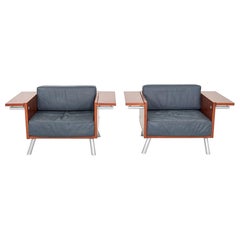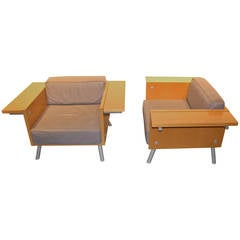Knoll Salsa
1990s Pair of Knoll Salsa Lounge Chairs by Paul Aferiat and Peter Stamberg
By Knoll
Located in Philadelphia, PA
This is a Pair of Knoll Salsa Lounge Chairs, designed by Paul Aferiat and Peter Stamberg in 1994
Category
1990s American Modern Lounge Chairs
Materials
Steel
$6,000 / set
H 24 in W 31 in D 31 in
Recent Sales
Knoll Stamberg Aferiat, Salsa Lounge Chairs with Shelves
By Knoll
Located in Hamilton, Ontario
Pair of Knoll Stamberg Aferiat, Salsa lounge chairs with shelves.
Peter Stamberg and Paul
Category
Late 20th Century American Modern Lounge Chairs
People Also Browsed
Riviera Plinth Tall in Oiled African Mahogany Designed by Yaniv Chen for Lemon
By Lemon
Located in Amsterdam, NL
Yaniv Chen, the designer behind the Riviera Plinths for Lemon, draws inspiration from a childhood memory and a lifelong fascination with lattice patterns. Exploring conservatories as...
Category
2010s South African Minimalist Pedestals
Materials
Wood
$1,807 Sale Price / item
20% Off
H 43.31 in W 10.83 in D 10.83 in
Willy Guhl Loop Table
By Willy Guhl
Located in Los Angeles, CA
The Willy Guhl Loop table is an icon of Swiss modernist furniture design. The Loop Table (also known as the Beach Table) was designed by Swiss industrial designer Willy Guhl in 1954....
Category
Early 2000s Swiss End Tables
Materials
Cement
Milo Baughman for Thayer Coggin Swivel and Tilt Chairs
By Thayer Coggin, Milo Baughman
Located in St.Petersburg, FL
An iconic pair of swivel and tilt chairs designed by Milo Baughman for Thayer Coggin. Chairs are every bit as comfortable as they are good looking. Unmarked, as they appear to have b...
Category
Vintage 1970s American Mid-Century Modern Swivel Chairs
Materials
Upholstery
Baleri Italia Cartoons Screen in Havana Paper by Luigi Baroli
By Baleri Italia, Luigi Baroli
Located in Milano, Lombardia
Screen with free-standing structure in corrugated paper-board extracted from pure cellulose. Completely recyclable and non-pollutive. Upper and lower edges in techno-polymer in matte...
Category
21st Century and Contemporary Italian Modern Screens and Room Dividers
Materials
Paper
$1,504 / item
H 66.93 in W 157.49 in D 15.75 in
Evert Sodergren African Tribal Stool Modernist Sculpture, Signed
By Evert Sodergren
Located in Brooklyn, NY
A sublime African tribal stool or headrest sculpture by Evert Sodergren, comprising gently carved legs supporting a bent lamination seat punctuated by visible joinery. This design wa...
Category
20th Century American Abstract Sculptures
Materials
Walnut
Early Pierre Chapo 'Godot' Daybed in Solid Elm
By Pierre Chapo
Located in Waalwijk, NL
Pierre Chapo, 'Godot' daybed, model 'L01I', solid elm, fabric, France, 1959
This daybed is an early edition designed by the French designer and master woodworker Pierre Chapo (1927-...
Category
Vintage 1960s French Daybeds
Materials
Elm
Gervasoni Brise 46 Coffee Table by Federica Biase
By Gervasoni, Federica Biasi
Located in Brooklyn, NY
Outdoor conviviality is the key of one of the collections by Federica Biasi. Brise, literally breeze, aims at taking us back to that pleasant sensation when a breeze makes the summer...
Category
21st Century and Contemporary Italian Modern Side Tables
Materials
Concrete
Vladimir Kagan Architectural Louvered & Illuminated Room Divider with COA, 1967
By Vladimir Kagan
Located in Brooklyn, NY
An incredibly rare louvered and illuminated room divider in solid walnut floating over a cylindrical brass foot, custom-designed by Vladimir Kagan circa 1967. Six sculptural, marquis...
Category
Vintage 1960s American Mid-Century Modern Screens and Room Dividers
Materials
Brass
$38,000
H 82 in W 42 in D 6 in
Exceptional Art Deco Arm Chair in Blue Velvet and Maple, Northern France, 1920s
Located in The Hague, NL
This exceptional armchair was produced by a master cabinetmaker in Northern France in the late 1920s. The chair was designed for a private residence in the Roubaix region.
The diffe...
Category
Vintage 1920s French Art Deco Armchairs
Materials
Fabric, Chenille, Cotton, Linen, Upholstery, Velvet, Maple
$11,388
H 34.45 in W 26.19 in D 35.04 in
Paul Evans for Paul Evans Studio Early and Rare Loop Cabinet in Copper
By Paul Evans
Located in Waalwijk, NL
Paul Evans for Paul Evans Studio, ‘Loop’ wall-mounted cabinet, welded copper with applied verdigris patina, steel, brass, painted wood, United States, circa 1968
Made around 1968, t...
Category
Vintage 1960s American Mid-Century Modern Cabinets
Materials
Brass, Copper, Steel
$152,000
H 53.15 in W 37.01 in D 21.66 in
Galerie Elm Wood Side Table
Located in Old Town Orange, CA
The artisanal construction methods highlight the elm woods beautiful grain pattern & knots and fissures from its past life.
The most authentic materials are hand selected, and hours...
Category
21st Century and Contemporary Organic Modern Side Tables
Materials
Elm
Set of 2 Mid Century Modern Parsons Club Chairs Manner of Milo Baughman, 1970s
By Milo Baughman
Located in Deland, FL
Ultra stylish and grand in scope this set of chic Parsons club chairs, in the manner of Milo Baughman, is the epitome of American Contemporary Design. Shown in their original polyest...
Category
Vintage 1970s American Mid-Century Modern Lounge Chairs
Materials
Fabric
$10,925
H 30 in W 30 in D 30 in
Unique Alfredo Barbini Scavo Glass Medusa Murano Pendant with Brass Canopy
By Alfredo Barbini
Located in San Francisco, CA
Alfredo Barbini, of Murano, Italy, produced incredible glass works during his long career including pendants, lamps and vases. This Medusa pendant exemplifies the technique of Scavo,...
Category
Vintage 1970s Italian Mid-Century Modern Chandeliers and Pendants
Materials
Blown Glass, Murano Glass
Twist & Knot Multicolor Chair in Rope with Brass legs, Viya by Vikram Goyal
By Viya by Vikram Goyal
Located in Noida, DL
Twist & Knot Multicolor Chair in Rope with Brass legs, Viya by Vikram Goyal
Immersed in the heritage of India's ancient artistry, the humble rope transports us to the heart of craft...
Category
21st Century and Contemporary Indian Chairs
Materials
Brass
$1,865 / item
H 35 in W 24 in D 21 in
Pierre Chapo sfax dining table T21E France 1965
By Pierre Chapo
Located in Roosendaal, Noord Brabant
This beautiful T21E dining table from 1965 by Pierre Chapo exemplifies Chapo’s signature style and craftsmanship. Made with the utmost attention to detail, the T21D features a solid ...
Category
Vintage 1960s French Mid-Century Modern Dining Room Tables
Materials
Elm
Pair of Original Charles Zublena Polyester Patio or Pool Side Lounge Chairs, '60
Located in Voorburg, NL
Stunning pair of original French, 1960s Polyester Patio or pool side chaise lounge chairs in white, designed by Charles Zublena. Directly from the first owner and in original conditi...
Category
Vintage 1960s French Mid-Century Modern Lounge Chairs
Materials
Polyester
$2,936 / set
H 23.63 in W 30.32 in D 63 in
Get Updated with New Arrivals
Save "Knoll Salsa", and we’ll notify you when there are new listings in this category.
More Ways To Browse
Lama Chrome
Large Round Lounge Chair
Larsen Barrel Chair
Leather Lounge Chairs Eric Merthen
Ligne Roset Fireside
Lou Hodges Chair
Lounge Chai
Low Fiberglass Chair
Low Japanese Chair
Mad Men Chairs
Manou Chair
Mantis Chair
Marc Newson Felt Chair
Marc Newson Gluon
Marcel Breuer D4
Marco Zanuso Woodline Chair
Martin Visser Wicker And Chrome
Martingala Chair

